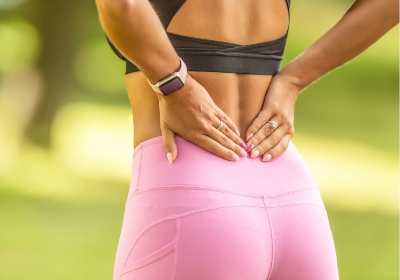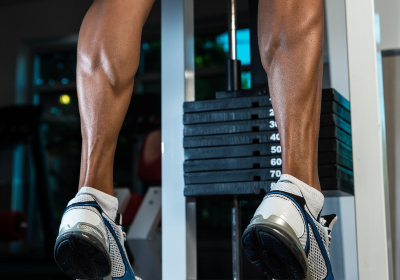VIDEO
Ice Skater
- Lower Back
- Quads
- Thighs
- Calves
Level:Intermediate
Trainer:Nick Taylor
Equipment:No Equipment
Ice Skater
- Lower Back
- Quads
- Thighs
- Calves
Level:Intermediate
Trainer:Nick Taylor
Equipment:No Equipment
Mark two imagenary spots on the surface. Stand on the right leg, bending your left leg at the knee. Hop from from one side to another switching your legs. Continue for the desired amount of repetitions.
save to ...
RECOMMENDED FOR YOU
ARTICLES
The hips are some of the strongest muscles in the human body. They keep the torso upright, control the hip and knee joints, and are engaged during various activities and even at rest. Their proper functioning is extremely important, and anyone should know how they function.
The muscles located on the hip are involved in both hip and knee movements, providing different positions of the hip in space depending on the proximal or distal support. Topographically, the hipі are divided into three groups. The anterior group includes the flexors: the quadriceps and the tailor muscle. The medial group consists of the hip drive muscles: the comb, the long, short, big adductor, and the thin muscle. The posterior group includes the hip extensors: biceps femoris, semitendinosus, and semi-perineal.
The lateral outer and inner thigh muscles are considered antagonistic pairs: while one group is working, the other group relaxes. The abductors, including the middle gluteal, small gluteal, thigh broad fascia tensor, pear, and tail muscles are responsible for your leg movements from the middle of your body.
Essentially, whenever you take a step to the side or turn your foot on the bed, you are activating the abductors. The inner thigh muscles, particularly the large adductor, small adductor, short adductor, and long adductor muscles perform the opposite task, working whenever you move your leg toward the center of your body.
Strong and injury-resistant athletes have well-trained hip muscles. This is very important when it comes to fast sports with a lot of lateral movements, such as tennis or basketball, but also when you want to work out without pain. If your goal is to strengthen your hip muscles, which is really important, but you don't have your favorite leg workout, we will share some great exercises with you.
Wide Squats. Every leg workout should include different variations of squats. This exercise targets the lower body, including the inner and outer thighs. But to really engage your thigh muscles, you should do deep squats with your legs turned outward.
Sumo Deadlift. The Sumo deadlift is based on a similar leg position as in the wide squat. However, it is the external rotation of the thigh muscles that results in increased involvement of the inner and outer thighs.
Side Leg Raises. A 2005 study published in the Journal of Orthopedic and Sports Physical Therapy found that side leg raises without weights are just as effective as other weighted exercises.
Side Leg Pull-Ups. The pull-up exercise can be done anywhere because you don't need anything but a comfortable mat. This is a great exercise that you can add to your daily home workout routine.
Read more
Your lower back includes the 5 vertebral bones that are placed on top of each other with intervertebral discs. The bones are connected there using unique joints. The lumbar spine is matched with the thoracic region above and the thighs below.
Individual anatomical structures include :
Vertebrae. It protects important nerve tissues such as the spinal cord and cauda equina.
Disks. The discs usually provide cushioning and cushioning to protect the vertebrae during spinal movements.
Facet joints give a little stability and allow the spine to move in various directions. The facets of the upper lumbar vertebrae are almost the same as the facet joints of the chest and, as it was already written, the main aim is controlling the movement of the spine.
The facets of the lumbar are more flexible and facilitate side-to-side movement.
The large muscles and complex network of ligaments support serve to stabilize it and enhance your twisting and bending movements.
The lumbar supports most of the body. A lot of people feel this kind of pain at some point sometimes. Sedentary muscle atrophy is common, especially if you work in an office and lead a relatively sedentary lifestyle. If you want to make your lower back stronger, start with a regular training program that consists of strength training, stretching, and aerobics or cardiovascular exercise.
Training
Child's pose. Get on all fours and stretch your arms out in front of you. Gently lower your buttocks to your heels. Lower your head to the floor and push your palms forward until your arms are fully extended. Stay in this position for 30 seconds.
Lunges. Lunge with your right foot forward, rest on your hands. Please note that the right hand should be to the left of the leg. Step your right foot about the width of your right hand. Next, without moving your arms, swing your hips forward to stretch the front of the thighs, and hold in this position for 30 seconds. Do the same with the other leg.
Seated crunches. Sit with your legs straight, then bend your knees and bring your left leg over your right, placing it on the outside of your right thigh. Pull your right foot closer to your right buttock. Next, bend your right arm at the elbow and put it behind your left knee, as if keeping yourself twisted. Hold this position for 30 seconds. and repeat the same for the other leg.
Happy child. Lie on the floor, as you exhale, pull your knees to your stomach. As you inhale, grab the outer sides of your feet with your hands. Slightly spread the knees to the sides slightly wider than the body, pull the knees to the armpits. Make sure your shins are perpendicular to the floor. Hold this pose for 30 seconds.
Twisting. Lie on the floor and bend your knees, take your legs to the side, for example to the right. In this case, the left leg should lie on the floor, and the right ankle should be above the left knee. Place your hands next to your head, with your right knee strive downward (to the floor). Stay in this position for 30 seconds. alternately for each side.
Read more
One of the most important running muscles is the quadriceps - the large muscle at the front of the thigh. It has been scientifically proven that regular strength training improves workout performance and reduces the risk of injury, as well as strengthens your back, and leg muscles, making your running more productive.
The quads, also known as the quadriceps muscle, is a group of muscles located at the front of the leg above the knee. It is one of the largest and strongest muscles in your body that consists of four heads: fastus medialis (medial wide), vastus intermedius (intermediate wide), vastus lateralis (lateral), and rectus femoris (straight thigh muscle). Almost every action performed by the legs involves two or more heads of the quadriceps. The quadriceps muscle plays an important role at the beginning of the movement (quick start) and during ascent and descent in elevated positions - which is why you may experience painful sensations in this area of the leg after an intense uphill workout.
According to researchers at the University of Delaware, strong quadriceps act as cushioning and can protect the knees and the entire musculature of the hip from common running injuries. Often many runners are injured because they have weak and underdeveloped quadriceps, so it is especially important to strengthen them.
By training and strengthening the quads, you can get the following benefits when running:
Increased speed. Strong quadriceps help you tackle steep hills and climbs more easily and make pushing off the ground more powerful, resulting in increased speed.
Reduced injuries. According to research, poorly developed quadriceps are often associated with many running injuries. For example, a common injury such as the 'runner`s knee' results from weakness in these muscles, which are unable to stabilize the knee joint during the movement.
Increased endurance. Strengthening the quadriceps muscle will make your running more effortless and efficient, which contributes to increased running volume and endurance.
Training
The quadriceps occupy 70% of the muscle mass of the leg, so it is their development that is fundamental in leg training. The main exercise for developing the quadriceps is the squat. But, for beginners, at the first stages of training, it is better to start with leg curls sitting in an exercise machine, leg press, and hyperextensions to strengthen the lower back, to avoid injuries, in order to prepare the base for the heavy squats. It is a good idea to include squats in your training plan after about six months of training.
Read more
Building up the calf muscles and make your legs beautiful is quite difficult, but possible. It is difficult because the legs are used to constant strain (usually people walk a lot). And it becomes possible thanks to the proven exercises, which can effectively train this group of muscles. In this article, we will take a detailed look at the anatomy of calves, their functions, and exercises that you can do to help make them stronger.
The calf muscle is the most superficially located muscle of the lower leg that crosses two joints: the knee and ankle. Like the biceps of the shoulder, it consists of two heads: medial (located closer to the inside of the tibia) and lateral (located closer to the outside of the tibia). It is interesting to note, that about 5.5% of Japanese and about 3% of people of other nationalities may have the 3rd head of the calf muscle, which attaches from above between the fixation sites of the medial and lateral heads, and may connect from below either to the lateral head (less often) or to the medial head (more often).
The primary function of the calf muscle is to lift the supporting leg, which causes a person to move forward along with flexion of the knee and ankle joints. Running causes a lot of stress on the calf muscles that is why many sprinters face the problem of calf pain.
There are also other functions of the calf muscle.
The calf muscle is involved in the plantar flexion of the foot, which occurs during walking, running, or cycling;
It is also activated during flexion of the leg at the knee joint;
It participates in the supination of the foot (its outward rotation);
The calf muscle takes part in the stabilization of the knee and ankle joints and also helps to keep the balance in the upright position of the body.
There are many reasons that can cause calf pain. And to prevent this unpleasant situation, the following rules should be followed:
running at a comfortable pace;
warming up before running and stretching after training;
comfortable shoes suitable for running;
a smooth transition from running to stopping after a step;
drinking plenty of water after the workout;
a warm shower/bath and a massage to relax the muscles.
The reasons why the calf muscles are not as developed as you would like them to be could be the following:
too much training aimed at working out this muscle group;
not enough exercise;
the wrong set of exercises.
It is necessary to choose the right exercises for the calf muscles. It must be noted that the surface muscle is worked out in a standing position, and the cambalic muscle in a sitting position. To train as effectively as possible, it is necessary to load both muscles.
And the last, but not the least advice: do not try to achieve serious results by performing endless repetitions, such as deadlifts. The main secret of how to pump up the calf muscles is heavy training with weights. It is recommended to train your calves no more than 2 times a week.
Read more
SAVE TO ...




